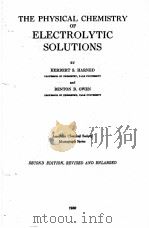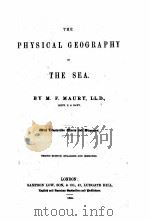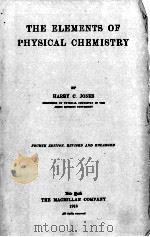《THE PHYSICAL CHEMISTRY OF ELECTROLYTIC SOLUTIONS SECOND EDITION》
| 作者 | HERBERT S. HARNED AND BENTCN B 编者 |
|---|---|
| 出版 | 未查询到或未知 |
| 参考页数 | 645 |
| 出版时间 | 1950(求助前请核对) 目录预览 |
| ISBN号 | 无 — 求助条款 |
| PDF编号 | 812005028(仅供预览,未存储实际文件) |
| 求助格式 | 扫描PDF(若分多册发行,每次仅能受理1册) |

1.GENERAL THERMODYNAMIC INTRODUCTION1
(1)Energy,Entropy and the Chemical Potentials of Gibbs1
(2)Heat Content,Work Content and Free Energy2
(3)Systems at Constant Composition and Charge3
(4)Systems at Constant Pressure,Temperature and Charge.Partial Molal Quantities4
(5)Systems at Constant Temperature and Pressure.The Reversible Galvanic Cell5
(6)The Activity Function.The Activity of an Electrolyte6
(7)Variation of Activity with Temperature and Pressure8
(8)Variation of Activity with Composition at Constant Tem-perature and Pressure.Definitions of Activity Coef-ficients9
(9)Activity Coefficient and Osmotic Coefficient of Solvent12
(10)The Equilibrium Constant of a Chemical Reaction14
(11)Surface Tension.The Adsorption Equation of Gibbs16
2.GENERAL STATEMENT OF THE INTERIONIC ATTRACTION THEORY AND PROPERTIES OF IONIC ATMOSPHERES17
(1)The Distribution Functions19
(2)The Time Rate of Change of the Distribution Functions22
(3)The Equations of Motion23
(4)The Fundamental Equations for the Potentials of an Ion and Its Atmosphere in the Absence of External Fields24
(5)General Equations for the Perturbations of Ionic Atmos-pheres29
(6)General Consideration of the Behavior of Ionic Atmospheres in Perturbed States30
3.THEORY OF THERMODYNAMIC PROPERTIES OF AQUEOUS SOLUTIONS32
(1)Properties of 1/k32
(2)Methods of Computing Work Content and Chemical Po-tential33
(3)The Charging Process and the Calculation of the Electro-static Contribution to the Chemical Potential34
(4)The Limiting Law for the Variation of the Activity Coficient with Concentration34
(5)The Effect of the Apparent Diameters of the Ions.Equations for the Activity and Osmotic Coefficients37
(6)The Development of the Extended Terms of the Debye and Hückel Theory According to Gronwall,LaMer and Sandved39
(7)Bjerrurg's Theory of Ionic Association42
(7A)The Theory of the Formation of Triple Ions and Quadrupoles According to Fuoss and Kraus46
(8)The Limiting Equations for the Relative Partial Molal Heat Content and Relative Partial Molal Heat Capaeity48
(9)The Limiting Equations for the Relative Partial Molal Volume,Expansibility and Compressibility of an Electrolyte50
(10)Salting Out and Salting In of Molecules or Electrolytes51
(11)The Theoretical Limiting Law for Surface Tension of Electrolytic Solutions59
4.THE THEORY OF IRREVERSIBLE PROCESSES IN ELECTROLYTIC SOLUTIONS63
(1)Time Lags63
(a)The Time of Relaxation of the Ionic Atmosphere63
(b)Time Iags of Processes of Ionic Combination66
(2)Viscosity.Theory of Falkenhagen67
(a)A preliminary Discussion of Viscosity67
(b)Outline of the General Solution of the Viscosity Problem70
(3)Condnctance.Theory of Onsager75
A.General Considerations and Preliminary Theory75
(a)Preliminary Estimate of Force Transfer76
(b)Preliminary Treatment of Electrophoresis77
B.Outline of the General Theory of Conductance According to Onsager78
(a)Electrophoresis78
(b)The General Theory of Ionic Forces Specialized for Conductance and Diffusion80
(c)The Limiting Law of the Conductance of Electrolytes in Low Fields and at Low Frequency.Electrolytes Which Dissociate into Two Kinds of Ions81
Electrolytes Which Dissociate into any Number of Ions84
(4)Diffusion of Electrolytes.Theory of Onsager86
(a)Some General Considerations86
(b)The Theory of Diffusion of a Simple Electrolyte87
(5)The Dependence of Conductance and Dielectric Constants of Solutions of Strong Electrolytes Upon the Frequency.Theory of Debye and Falkenhagen90
(a)Equations for Potentials and Forces in an Alternating Field90
(b)Equations for Conductance and Dielectric Constant Lowering in an Alternating Field94
(6)Theory of the Effects of High Fields on the Properties of Strong Electrolytes.Wien Effect95
(a)The Boundary Conditions97
(b)Simplification of the Fundamental Differential Equations for the Distribution Functions and Potentials100
(c)Solution of the Differential Equations101
(d)Electrophoresis102
(e)The Ionic Field103
(f)The Functions,f(x) and g(x),in Convenient Forms for Numerical Computation103
(g)The Conductance Equation Modified for the Wien Effect104
(7)Influence of High Fields on the Ionization of Weak Electrolytes.Theory of Onsager106
5.NUMERICAL COMPILATIONS OF PHYSICAL CONSTANTS,CHARAC-TERISTIC SLOPES,AND MATHEMATICAL FUNCTIONS115
(1)Fundamental Physical Constants115
Dielectric Constants115
Ionic Radii117
(2)Equations Derived in Chapter(3)for the Calculation of Thermodynamic Properties from the Electrostatics of Ionic Atmospheres117
Functions of Bjerrum's Theory of the Association of Ions122
Functions of the Fuoss and Kraus Theory of Triple Ion Association123
Limiting Slopes for the Relative Partial Molal Heat Content and Heat Capacity in Aqueous Solutions124
Limiting Slopes for the Relative Partial Molal Volume,Expansibility and Compressibility of an Electrolyte125
Theoretical Laws for the Increase of Surface Tension125
(3)Equations Derived in Chapter(4)Involving the Dynamics of Ionic Atmospheres126
Limiting Law for Viscosity126
Limiting Slope for the Equivalent Conductance of a Strong Electrolyte127
Theory of Diffusion129
Theory of Frequency Effects130
Effects of High Fields on Conductance of Electrolytes131
The Dissociation Field Effect132
6.EXPERIMENTAL INVESTIGATION OF IRREVERSIBLE PROCESSES IN SOLUTIONS OF STRONG ELECTROLYTES.CONDUCTANCE,TRANS-FERENCE NUMBERS,VISCOSITY AND DIFFUSION135
(1)Equivalent Conductance,á.Primary Standards135
(2)The Onsager Conductance Equation.Comparison with Experiment139
(3)Extensions of the Onsager Equation.Evaluation of Λ0144
The introduction of Finite Dissociation Constants145
Theoretical Extensions Based Upon the Assumption of Complete Dissociation148
Purely Empirical Extensions152
(4)Other Conductance Equations.Critical Summary154
(5)Transference Numbers by the Moving Boundary Method.Fundamental Equations158
(6)The Onsager Limiting Equation for Transference Numbers.Comparison with Experimental Results162
(7)Equations for Transference Numbers at Moderate Dilutions.Evaluation of T?166
(8)Limiting Ionic Conductance.Kohlrausch's Law169
(9)Viscosity of Solutions of Strong Electrolytes and Its Dependence Upon Concentration172
(10)Diffusion of Electrolytes178
7.COULOMB FORCES AND ION ASSOCIATION;WEAK ELECTRODYTES;FREQUENCY AND FIELD EFFECTS183
(1)Stoke's Law and Walden's Rule183
(2)Association into Ion Pairs.Estimation of Dissociation Constants186
(3)Confirmation of Bjerrum's Extension of the Theory of Inter-ionlc Attraction.Ion Pair Formation as a Function of the Dielectric Constant190
(4)Association into Complex Aggregates.Triple Ions,Quad-rupoles,and the Conductance Minimum193
(5)Influence of Ionic Size and Structure Upon Conductance and Association202
(6)The Ionization of Weak Electrolytes206
(7)Experimental Investigations of the Effect of Frequency on Conductance and Dielectric Constant211
(8)The Effect of High Electric Fields Upon the Conductance of Electrolytes214
The Wien Effect for Strong Electrolytes214
The Wien Effect for Weak Electrolytes,or the Dissociation Field Effect216
8.THERMOCHEMICAL QUANTITIES,PARTIAL MOLAL VOLUMES,AND THE COEFFICIENTS OF EXPANSION AND COMPRESSIBILITY223
(1)Introduction223
(2)The Relative Apparent Molal Heat Content,Heat of Dilution,and Relative Partial Molal Heat Content223
(3)Heats of Neutralization and Heats of Ionization239
(4)The Partial Molal Heat Capacity at Constant Pressure241
(5)Partial Molal Volumes,Apparent Molal Volumes and the Densities of Solutions of Electrolytes250
(6)The Partial Molal Expansibility,Apparent Molal Expansibility,and the Coefficient of Thermal Expansion of Solutions of Electrolytes262
(7)The Partial Molal Compressibility,Apparent Molal Compressibility,and the Coefficient of Compressibility of Solutions of Electrolytes267
9.THE CALCULATION OF ACTIVITY AND OSMOTIC COEFFICIENTS FROM FREEZING POINTS,BOILING POINTS AND VAPOR PRESSURES281
(1)Introduction281
(2)General Equations for Calculating the Activity of the Solvent and the Osmotic Coefficient from Freezing-Point De-pressions283
(3)General Equations for Calculating the Activity of the Solvent and the Osmotic Coefficient from Boiling-Point Elevations285
(4)General Equations for Calculating the Activity of the Solvent and the Osmotic Coefficient from Vapor Pressure Measure-ments and Isopiestic Comparisons287
(5)Calcuiation of the Activity Coefficient of the Solute from the Osmotic Coefficient or Activity of the Solvent288
10.THE THERMODYNAMICS OF GALVANIC CELLS297
(1)General Thermodynamic Properties of Cells.Defmition of the Standard Electrode Potential297
(2)Conventions Regarding the Representation of Cells and Electrodes,and the Signs of Their Electromotive Forces299
(3)Extrapolation of Electromotive Force Data and Evaluation of the Standard Molal Electrode Potential304
(4)Determination of Activity Coefficients by Extrapolation of the Electromotive Forces of Concentration Cells Without Liquid Junctions305
(5)The Computation of the Relative Partial Molal Heat Content and Relative Partial Molal Heat Capacity of Electrolytes from Electromotive Force Data307
(6)The Concentration Cell with Liquid Junction309
The Hypothetical Liquid Junction Potential312
The Concept of Electrical Potential at Phase Boundaries314
(7)The Use of Cells with Liquid Junctions.Determination of pH.Elimination of Liquid-Junction Potentials316
11.HYDROCHLORIC ACID326
(1)Conductance of Hydrochloric Acid in Dioxane-Water Mixtures326
(2)The Standard Potential of the Cell H2|HCl(m)|AgCl-Ag in Aqueous Solutions328
(3)The Standard Potential of the Cell:H2|HCl(m),S(X),H2O(Y)|AgCl-Ag in Organic Solvent-Water Mixtures331
(4)The Activity Coefficient of Hydrochloric Acid in Aqueous Solutions340
(5)Calculation of the Activity Coefficient of Hydrochloric Acid in Water by the Extended Debye and H?ckel Theory.341
(6)The Activity Coefficient of Hydrochloric Acid in Media Con-taining Organic Solvents345
(7)The Relative Partial Molal Heat Content of Hydrochloric Acid.Numerical Methods for Computing L2 from Electromotive Forces346
(8)The Relative Partial Molal Heat Capacity of Hydrochloric Acid350
(9)The Transference Numbers of Hydrochloric Acid in Water and Dioxane-Water Mixtures from 0 to 50°352
12.STRONG 1-1 ELECTROLYTES IN AQUEOUS SOLUTIONS358
(1)The Thermodynamics of Sodium Chloride Solutions from Electromotive Forces and Calorimetric Data358
(2)The Thermodynamics of Hydrobromic Acid,Potassium Chloride,Sodium Bromide,and Sodium and Potassium Hydroxides in Aqueous Solution366
(3)The Activity Coefficients of 1-1 Electrolytes from Isopiestic Vapor Pressure Measurements373
(4)Calculation of the Activity Coefficient at Various Temperatures and Pressures from Values at 25° and One Atmosphere375
(5)General Discussion of the Activity Coefficients of 1-1 Electrolytes in Relation to the Theory of Debye and H?ckel379
(a)The Mean Distances of Approach of Ions,ü379
(b)Specific Behaviors of 1-1 Electrolytes383
(6)Br?nsted's Postulates of Specific Ionic Interaction,and Guggenheim's Method of Computation of Osmotic and Activity Coefficients at Low Concentrations386
(7)The Theory of Concentrated Solutions of Alkali Halides According to Scatchard389
(8)Interpretation of Concentrated Solutions of Electrolytes in Terms of a van der Waal's Co-Volume Effect391
(9)Thermodynamic Properties of Ions in Relation to Their Size and Structure394
(10)Activity Coefficients of Neutral Molecules in Aqueous Salt Solutions397
(11)The Surface Tension of Dilute Solutions of Electrolytes405
(12)Critical Considerations407
13.POLYVALENT ELECTROLYTES410
(1)The Thermodynamics of Magnesium,Calcium,Strontium and Barium Halide Solutions411
(2)The Thermodynamics of Aqueous Lithium,Sodium and Potassium Sulphate Solutions413
(3)Halides of Zinc,Cadmium and Lead in Aqueous Solution414
(4)General Considerations Regarding 1-2 and 2-1 Electro-lytes in Aqueous Solutions422
(5)The Thermodynamics of Aqueous Zinc Sulphate Solutions423
(6)Activity Coefficients of the Sulphates of Bivalent Metals in Aqueous Solution425
(7)1-3,3-1,3-2,and 1-4 Electrolytes426
(8)The Ionization Constant of HSO? from Electromotive Force Measurements429
(9)The Standard Potential of the Cell:H2|H2SO4(m)|PbSO4-PbO2-Pt430
(10)The Activity of Water in Aqueous Sulfuric Acid from Electromotive Force and Vapor Pressure Measurements435
(11)The Activity Coefficient of Sulfuric Acid436
(12)The Standard Potential of the Cell:H2|H2SO4(m)|Hg2SO4-Hg438
(13)The Relative Partial Molal Heat Content and Heat Capacity of Sulfuric Acid in Aqueous Solution439
(14)The Cation Transference Number of Sulfuric Acid in Aqueous Solution443
14.MIXTURES OF STRONG ELECTROLYTES444
(1)Solubility Measurements and the Interionic Attraction Theory445
(2)The Activity Coefficients of Hydrochloric,Hydrobromic,and Sulfuric Acids,and of Alkali Metal Hydroxides in Salt Solutions from Electromotive Force Measurements450
(3)The Relative Partial Molal Heat Content of 0.01 M Hydro-chloric and Hydrobromic Acids in Halide Solutions454
(4)The Variation of the Activity Coefficient of One Electrolyte in the Presence of Another at Constant Total Ionic Strength454
(5)Thermodynamic Theory of Mixtures at Constant Total Molality461
(6)General Survey of the Experimental Investigations of 1-1 Halide Mixtures466
(7)Further Considerations of the Theory of Specific Ionic Interaction472
(8)Hydroxide-Chloride Mixtures474
(9)Extrapolation of Activity Coefficients to Saturated Solutions.Calculation of the Solubility of Highly Soluble Salts in Solutions of Electrolytes476
15.THE IONIZATION AND THERMODYNAMIC PROPERTLES OF WEAK ELECTROLYTES480
(1)The Ionization Constant of Water481
(2)The Activity Coefficient Function,rHrOH/aH2O,and the Ionization Product,mHmOH,in Aqueous Salt Solutions486
(3)The Effect of Temperature and Pressure on the Ionization of Water.Thermochemical Quantities490
(4)Determination of the Ionization Constants of Weak Acids and Bases497
(5)Determination of the Ionization Constants of Ampholytes505
(6)The Calculation of Ionization Constants and the Derived Thermodynamic Functions,△H?,△S?,and △C?508
(7)Medium Effects.The Unbuffered Cell Without Liquid Junction516
(8)The Activity Coefficients of Weak Acids in Salt Solutions522
(9)Hydrolysis of Organic Anions in Salt Solutions527
(10)Theoretical Considerations529
(11)Additional Observations535
APPENDIX A537
APPENDIX B585
AUTHOR INDEX623
SUBJECT INDEX627
1950《THE PHYSICAL CHEMISTRY OF ELECTROLYTIC SOLUTIONS SECOND EDITION》由于是年代较久的资料都绝版了,几乎不可能购买到实物。如果大家为了学习确实需要,可向博主求助其电子版PDF文件。对合法合规的求助,我会当即受理并将下载地址发送给你。
高度相关资料
-

- SOLUTIONS MANUAL FOR PHYSICAL CHEMISTRY
- 1980 JOHN WILEY&SONS
-

- THE PHYSICAL GEOGRAPHY OF THE SEA SECOND EDITION
- 1855 SAMPSON LOW SON AND CO.
-

- STUDENT'S SOLUTIONS MANUAL FOR PHYSICAL CHEMISTRY SIXTH EDITION
- 1998 OXFORD UNIVERSITY PRESS
-

- SOLUTIONS MANUAL T ACCOMPANY PHYSICAL CHEMISTRY SEVENTH EDITION
- 1987 JOHN WILEY & SONS
-

- PHYSICAL CHEMISTRY SECOND EDITION
- 1980 ADDISON-WESLEY PUBLISHING COMPANY
-

- THE ELEMENTS OF PHYSICAL CHEMISTRY FOURTH EDITION
- 1918 THE MACMILLAN COMPANY
-

- THE GROWTH OF PHYSICAL SCIENCE SECOND EDITION
- 1951 AT THE UNIVERSITY PRESS
-

- SOLUTIONS GUIDE FOR CHEMISTRY SECOND EDITION
- 1989 D.C.HEATH AND COMPANY
-

- SOLUTIONS MANUAL FOR PHYSICAL CHEMISTRY
- 1990 OXFORD MELBOURE TOKYO
-

- SOLUTIONS MANUAL FOR PHYSICAL CHEMISTRY THIRD EDITION
- 1986 OXFORD UNIVERSITY PRESS
-

- SOLUTIONS MANUAL FOR ORGANIC CHEMISTRY SECOND EDITION
- 1980 JOHN WILEY & SONS
-

- Physical Chemistry of Electrolyte Solutions
- 1998 Springer
-

- A TEXTBOOK OF PHYSICAL CHEMISTRY SECOND REVISED EDITION 1980
- 1977 VIKAS PUBLISHING HOUSE PVT LTD.
-

- SOLUTIONS MANUAL FOR PHYSICAL CHEMISTRY SECOND EDITION
- 1982 W. H. FREEMAN AND COMPANY NEW YORK
提示:百度云已更名为百度网盘(百度盘),天翼云盘、微盘下载地址……暂未提供。➥ PDF文字可复制化或转WORD
